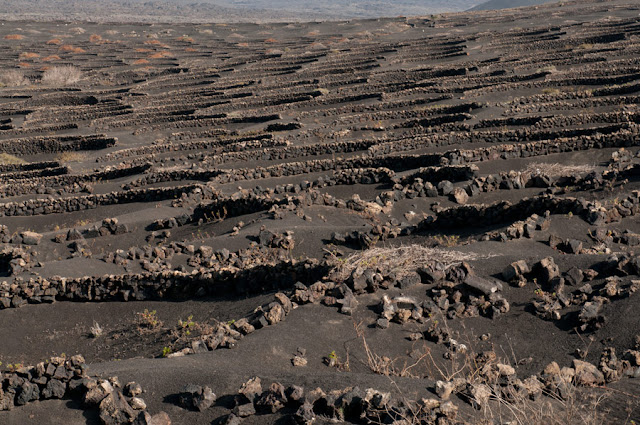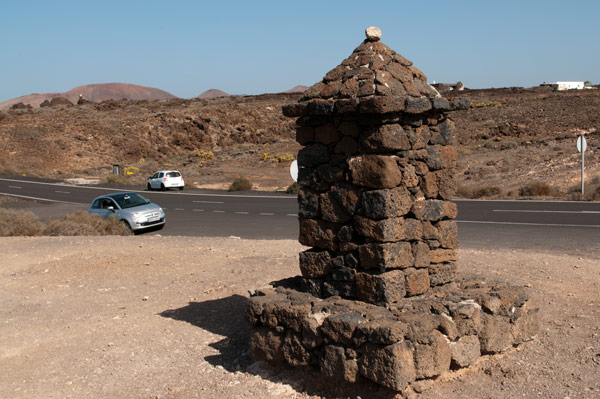After we explored
everything the island capital Arrecife has to offer we wanted to discover the unique volcanic landscapes and understand why the island name in the native language was Titerroygatra ("the red mountains") as we had not seen anything red there.
everything the island capital Arrecife has to offer we wanted to discover the unique volcanic landscapes and understand why the island name in the native language was Titerroygatra ("the red mountains") as we had not seen anything red there.
Even Pliny the Elder who was the first one to mention Canary Islands (then called Insulae Fortunatae – Fortunate Islands) called Lanzarote and Fuerteventura the archipelago of the "purple islands".
The modern name is believed to derive from the name of Genoese navigator Lancelotto Malocello. However every tour guide will be happy to give you his own version of the island’s name. For example, we heard a theory that celebrating the defeat of local tribes one of the islands conquerors broke his spear and shouted “Lanza Rota!” meaning “Spear is broken”. Or maybe Lancelotto himself exclaimed “Lanza Rota”?
Either way we will never find out the truth and isn’t it nice to be able to choose your own version?
So during one of our calls to Lanzarote we rented a car right at the terminal and headed north. There is not much traffic on the island as soon as you leave the capital and the navigation is relatively good. Our rental car company provided us with a detailed map containing not only the roads but also main attractions, all numbered, with little pictures and opening hours.
We did not have any specific plan so we just headed north to San Bartolome. As we left the capital we could see how dry and arid the island is and what great effort is required from local people to irrigate this otherwise fertile soils:
Despite these hardships it was evident how proud the people are of their home place and how much time and effort they put in decorating it:
We kept driving past San Bartolome towards Tiagua. There we stopped at Museo Agricola El Patio but it was still closed (the museum opens at 10:30am). If you decide to visit the museum it is easy to find as there are signs pointing at it from the main road. There is a parking lot next to the museum but we preferred to leave the car at a larger parking where tourist buses stop. It was a mere 5 minutes walk and on the way we saw some interesting agricultural techniques applied by local farmers. Agriculture in Lanzarote is a triumph of hard work over the hostile environment: the volcanic black ash is fertile but there is not enough water. So how does Lanzarote manage to survive as agricultural island? A unique method of dry cultivation called enarenado is utilized here. Porous volcanic particles are used as topsoil and are piled on top of the crops. Useless in themselves, they act as a sponge for the moisture in the night air obtaining water for the plants and eliminating need for rain. The topsoil needs replacing about every 20 years.
3 elements are typical of Lanzarote rural landscape: cactus plants, windmills & stone walls made without cement with rocks holding together by their own weight. These walls are used to protect the plants from the heavy winds.
Winds are also the reason why you will often see windmills without canvas on their sails: strong winds would simply rip it off! So the millers monitor the wind and only put the canvas back on when the wind is manageable.
We walked around a little, saw a typical local church: white-washed and sturdily built, with no bell tower as if it constantly tries to resist the winds.
After Tiagua we had a choice to either go to Timanfaya National park
Lunar Route ’. During the drive the narration about the park is provided including excerpts from the diary of a local Priest who was an eyewitness to the devastating Eruptions. But it is not allowed to leave the bus. Knowing how frustrating it could be not to be able to photograph all these stunning landscapes (well, it is still possible to make snaps through the window but…) we turned towards Mancha Blanca.
Lunar Route
We figured that the volcanoes on the island will look pretty much the same and did not feel like paying 8€ for the chance to see (and NOT photograph) one specific volcano (plus we are not too fond of tourist traps),
However Timanfaya National park
The trip starts from Islote de Hilario visitor’s center where you will be given a demonstration on how active the volcanoes still are. They will throw a piece of dry grass on the ground and it will ignite within seconds and demonstrate a sort of artificial geyser. Local restaurant 'El Diablo' will cook some traditional foods using geothermal heat (A cast-iron grill placed over a large hole in the ground). But this is not all. From the visitor's center there are 3 ways to explore the park: hiking (is only done in small groups and has to be booked 48 hours in advance), by camel or by coach on 'Lunar Route'. The coach trip is included in the admission fee. So if you already paid admission fee make sure you hop on the bus!
As to us - we headed towards Le Geria. On the way we saw a sign for a Mirador – viewpoint – and stopped to have a look. This Mirador is next to Mancha Blanca and from there we could see Ermita de Los Dolores but it is not marked on the map. Yet it offers a beautiful view over the terraced valley vividly demonstrating what it takes to make anything grow on this island. We will try to return in spring hoping the terraces will be full of greenery…
Soon after Mancha Blanca we saw a sign informing us we were entering Los Volcanes National Park
The landscape is so arid with not a tree in sign that it seems we are on Mars. But what amazed us that even here people were trying to cultivate plants: just look at the hill in the background.
Soon the lava landscape changed to something very different as we were in La Geria.
But first shall we play trivia? Can you tell what this is?
I bet the correct answer – vineyard – is not very obvious. Yet it is true, these are vineyards. La Geria is a sub-zone of the Lanzarote Denominación de Origen wine region using very unusual horticultural methods. Local vineyards unlike their French or mainland Spain
Of course enarenado is used here as well. Thanks to this technique every little drop of water – be it rain or overnight dew – is collected in the pits while stone walls protect the plant from the harsh winds. This method is so unique that the vineyards are part of the World Heritage Site.
Of course enarenado is used here as well. Thanks to this technique every little drop of water – be it rain or overnight dew – is collected in the pits while stone walls protect the plant from the harsh winds. This method is so unique that the vineyards are part of the World Heritage Site.
But of course how could we not taste some of the Lanzarote wines?
Our first stop was in Bodega Stratvs.
We both love dry wines and were afraid that local wines would be too sweet for us as there is enough sunlight to make the grapes sweet but not enough water to make them bigger. To our pleasant surprise we saw the bodega offered Malvasia seco (and our knowledge of Spanish was sufficient to figure out that seco means dry). The wine was very good and very unusual: it smelled and tasted like volcano (well, the driver could only appreciate the aroma :(). It has a sort of ashy taste but it is a pleasant addition to the bouquet.
Unfortunately from Bodega Stratvs you cannot get a good view of the vineyards as a certain elevation is needed to capture the vine pits:
For a better angle stop by Bodega La Geria: it is on a slightly higher hill and allows you to have a view from the top.
Bodega La Geria is a more tourist spot, though (as we were there 2 tourists buses from the ship arrived) and Malvasia was better in Stratvs. So you want to both taste good wine and take good pictures you need to stop at both.
For a better angle stop by Bodega La Geria: it is on a slightly higher hill and allows you to have a view from the top.
Bodega La Geria is a more tourist spot, though (as we were there 2 tourists buses from the ship arrived) and Malvasia was better in Stratvs. So you want to both taste good wine and take good pictures you need to stop at both.
Our last stop for the day was at Salinas de Janubio desalination plant. The coarse salt extracted here was once used to preserve fish. Nowadays the demand is less but local artists dye the salt a variety of colors and pour onto the streets of Arrecife creating religious pictures for Corpus Christi festivities every June.
Next to Salinas there is a restaurant Mirador de Salinas
At the time we were there (around 1pm) this point offers a better view as from the restaurant the basins look brown.
From the roadside the light reflects under a different angle and the basins are all shades of turquoise depending on the salinity of water in each of them.
From the roadside the light reflects under a different angle and the basins are all shades of turquoise depending on the salinity of water in each of them.
However the restaurant is sure worth a visit. We ordered muraena fish and fried squid from appetizers section and look what (and how much!) we got.
The food was simple yet fresh and thus delicious. These 2 huge plates that we barely finished and two glasses of wine (and again the driver did not get anything) costed us 22 euro.
Keep in mind the restaurant opens at 11:30am and is closed on Thursdays.
As we were already pretty tired we chose to drive back to the port but made note of this restaurant as we are planning to visit two more island attractions located in the area: Los Hervideros (“boiling”) – the cliffs with water constantly “boling” under them, and El Golfo – a natural green pool of unusual shape.
For the drive back we chose one of the main island roads so it took as about 20 minutes to get back to port.
Overall the trip took us around 5 hours (from 9:00am till slightly after 2:00pm).
To our disappointment the car rental office was closed. Typical of Spain Canary Islands . So by the time we explained which island we were on and which location we rented the car from we ran out of coins. After half hour wait we returned on ship, set alarm for 4pm and went out again just to give the key back. When we asked why there was nobody at the office the clerks seemed genuinely surprised: how could we expect anyone to be in the office during siesta? They close the office at 12:30 and only return at 4pm to collect the keys.
Learn from our experience: knowing how religiously Spaniards observe siesta always inquire about the opening times!
We enjoyed this drive around the island and cannot wait to do it again!
In the next part: our impressions on Cueva de Los Verdes and Jameos Del Agua, Mirador del Rio, Haria, Teguise and Playa Famara




























































